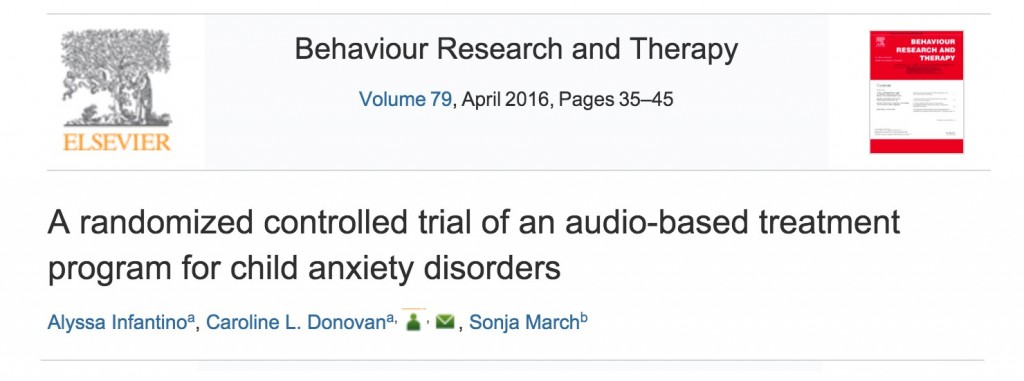Okay, I know this is blowing our own trumpet but mostly we are just really happy. Creating Turnaround to benefit kids suffering with child anxiety was a labor of love (really) but because we are biased we really wanted to know objectively that Turnaround is effective. In 2010 when we published it, we wanted someone to put it to the test.
We immediately started to get good feedback and we knew it was built on solid science. We also knew we were trying something completely new. We wanted objective evidence it was effective. The internet is full of promises. Because we were selling it, we knew people would cautious if not skeptical. We understood that, we would be as well. We knew it wasn’t a gimmick but we needed science to prove it. (Honestly, we were a little bit nervous that research would have been disappointing. That would have harshed my mellow. I would have done some 5-star sulking.)
We looked for researchers who were doing work with alternative ways of delivering treatment. We found that a lot of that research was being done in Australia. We made contact. Long story short, those researchers were interested and we sent them the kits. The study was approved and started in late 2012. All the data were collected and results were analyzed in Fall of 2013. The results were very significant to our relief. (Potential sulking was checked.)
The degree of effect pleasantly surprised the researchers**. The study was for a thesis which was passed and approved in early 2014. The authors began to prepare the results for submission for publication. It was accepted and published February 2016 in Behaviour Research and Therapy. As you can tell this is a long process. We want to thank Drs. Alyssa Infantino, Carolyn Donovan and Sonja March for seeing the possibilities of our unique way of getting help to kids and the long, hard work to see this through. I hope I can meet them face-to-face someday.
Here is a summary of key findings:
- Effective in reducing the clinical severity of the primary diagnosis
- Decreasing the number of diagnoses held
- Improving overall level of functioning
- Reducing child and parent report of anxiety symptoms
- Reducing internalizing behaviours*
- At post-assessment, 58.3% of children receiving treatment compared to 16.7% of waitlist children were free of their primary diagnosis, with this figure rising to 66.67% at the 3-month follow- up time point. (Comparable to face-to-face interventions.)
- Additionally, at post-assessment, 25.0% of children in the treatment condition compared to .0% of the waitlist condition were free of any anxiety diagnosis, with this figure rising to 41.67% for the treatment group at 3-month follow-up
- Similarly, in comparison to other alternative treatment programs, the audio treatment program appears to be a comparable and viable treatment option. It should also be noted that the programs used for comparison include therapist support, while Turnaround did not, making the results of the audio program particularly promising
- Parents and children also positively evaluated the program after completing it, reporting moderate to high levels of treatment satisfaction
*Internalizing here means negative behavior and thoughts about one’s self that are not externally evident. For example, the assessment question would be, “Feels worthless or inferior” or “Too anxious or worried.”
**Indicated in email from Dr. Infantino. Just so you know, the fewer subjects, the harder it is to get statistically effective results. The study had fewer subjects than they hoped and that made the degree of effect striking.

Joe says
Hi we have our 12 year old daughter who is suffering from emetophibia especially when going to school in the mornings. She has panic attack which usually settles after some time. Once we settle her at school she is fine with some sickening feelings throughout the day, but she stays the whole day. We have purchased the program including the emetophibia add on, we have gone thru the turnaround program and she showed small but promising improvement, now that she has finished the program she refuses to go over it again even after a setback today. She is refusing to start the emetophibia steps. We are unsure and are trying to remain positive and comfort her repeating our positive support. Do u have any suggestions?
Dr. Chris says
It appears the it’s the Emetophobia material that she really needs. It may be best to get a therapist involved to help her. Find someone who understands Emetophobia if possible. You can share the material with them. When a child becomes really resistant to working with their parent, it’s best to have them work with someone else. Encourage her to stay at now so that she doesn’t with it long-term… a hard thing to convince a 12 year of at times but nevertheless needed.
Shaelynn says
I have this. I’m in middle school. I stopped going to school last year because of anxiety. Hopefully this helps😄
Dr. Chris says
We’ve seen many kids helped by it. Are you going through the material?